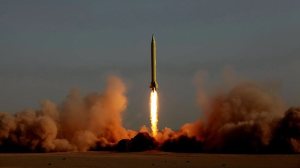By Jonah Aboni
The Iranian nuclear program is a source for international concern. The concern genuinely stems from the suspicion that the Iranian nuclear program might not be exclusively peaceful. Consequently, the United States and its P5+1 partners (China, France, Germany, Russia and the United Kingdom) have engaged in diplomatic talks to ensure Tehran's nuclear program is exclusively peaceful.
A comprehensive deal is within reach if the diplomats continue to engage in creative trade-offs and move towards bridging the gaps that exist and move away from their entrenched positions. However, myths and misconceptions about the negotiations and Iran's nuclear program persist that threaten to derail the talks. Until the November 24 deadline, the Arms Control Association will publish a weekly post debunking some of the most commonly held "myths" about Iran's nuclear program and what a comprehensive agreement will seek to achieve.
 Iran tests a Shahab-3 during exercises in 2012. Photo Credit: AFP
Iran tests a Shahab-3 during exercises in 2012. Photo Credit: AFP
MYTH: Iran is developing long-range ballistic missiles that could be armed with nuclear warheads
As the negotiations progress toward a comprehensive deal, rhetoric that is used by critics of the talks implies that Iran is developing long-range rockets to be armed with nuclear warheads. This is sometimes used to muddy the waters during the on-going negotiations.
Senator Marco Rubio (R-Fla.) was categorically wrong during a July 29, 2014 Foreign Relations Committee hearing on the Iranian nuclear program when he said that Iran is "developing a long-range rocket that will be able to reach the United States and other places in Europe. That is what they're developing and that's what they head towards.''
Rhetoric like this has the potential to damage the negotiations because in reality the facts don't seem to support the claims.
There is no serious evidence to back up all the claims that have been made about Iran developing long-range rockets to deliver nuclear warheads. The U.S. intelligence community assess that Iran may be technically capable of developing an ICBM with sufficient foreign assistance, not that they are doing so. Iran has never tested any long-range rockets. Iran's longest-range missiles are medium-range ballistic missiles, not the intercontinental-range missiles as critics will have us believe.
As far as the evidence shows, Iran is assessed to have deployed several dozen Shahab-3 and Ghadr-1 medium-range ballistic missiles with ranges up to 2,000 kilometers, as well as dozens of short-range ballistic missiles with ranges of 150 to 500 kilometers. Iran is testing a solid-fueled medium-range ballistic missile, the Sejjil-2, but that has not been tested since 2011 and the United States cannot confirm Iran's claims that this missile is deployed.
False claims about Iran's ballistic missiles just muddy the waters. Also, the best way of curtailing Iran's capability to deliver nuclear weapons is to ensure Teheran's nuclear program is severely limited, as the P5+1 negotiation is seeking to do. The necessary checks–transparency of the nuclear program, intrusive monitoring and verification on Tehran's nuclear activities and limits to its enrichment program--should be the focus of the negotiation.
A comprehensive deal that tightens all the loose ends of the Iranian nuclear program will prevent Iran developing nuclear weapons without detection. The attempts to introduce extraneous issues in the negotiations such as the banning of ballistic missiles capable of delivering nuclear warheads is unrealistic and superfluous in a final deal. There is no need to include issues which will unnecessary agitate a party to the negotiations and delay a deal from being reached soon when the same result being advocated will be achieved through a well laid out strategy in a comprehensive deal.
A comprehensive nuclear deal between Iran and the P5+1 is reachable. A deal that limits Iran's uranium-enrichment capacity, effectively blocks plutonium production, and guards against prohibited nuclear weapons related activities would reduce the potential dangers posed by Iran's ballistic missiles.
